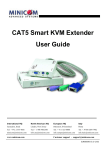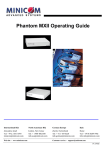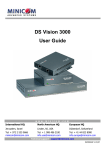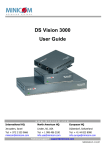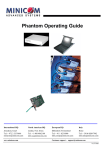Download Minicom Advanced Systems Minicom Supervisor Phantom Installation guide
Transcript
Phantom MX IP Installation Guide International HQ North American HQ European HQ Italy Jerusalem, Israel Linden, New Jersey Dübendorf, Switzerland Rome Tel: + 972 2 535 9666 [email protected] Tel: + 1 908 4862100 [email protected] Tel: + 41 1 823 8000 [email protected] Tel: + 39 06 8209 7902 [email protected] www.minicom.com Customer support - [email protected] 5UM20109 V1.2 11/03 PHANTOM MX IP Table of Contents 1. 2. 3. 4. 5. 6. 7. 8. 9. 10. 11. 12. 13. 14. 15. 16. 17. 18. 19. 20. 21. 22. 23. 24. 25. 26. 27. 28. 29. 30. 31. 32. 33. Welcome .........................................................................................................................................2 Introduction ....................................................................................................................................3 The MX IP system components ....................................................................................................3 Management units .........................................................................................................................3 Remote units ..................................................................................................................................4 Compatibility ..................................................................................................................................5 System features .............................................................................................................................5 System configuration ....................................................................................................................6 Remote power management .........................................................................................................7 MX IP front panel............................................................................................................................8 The MX IP rear panel ports ...........................................................................................................9 Pre-installation instructions .......................................................................................................10 The MX IP system cables ............................................................................................................10 Connecting the MX IP ..................................................................................................................10 Connecting the UPM....................................................................................................................11 Connecting the MX IP system ....................................................................................................12 Connecting the MX IP to the UPM ..............................................................................................12 Connecting the Specters to the MX IP system .........................................................................12 Connecting the Specter II PS/2...................................................................................................13 Connecting the Specter RS232 ..................................................................................................13 The RS232 power options ...........................................................................................................14 Connecting the Specter SUN ......................................................................................................14 Connecting the Specter USB ......................................................................................................15 Connecting the RS232 terminal..................................................................................................15 Controlling the RS232 Specters .................................................................................................16 Connecting the RS232 terminal..................................................................................................16 Connecting the IPMI option ........................................................................................................17 Connecting the Internal Reset/Power Option ...........................................................................18 Connecting the External Reset/Power Option ..........................................................................19 Connecting to Ethernet ...............................................................................................................19 10 Mbps Connection....................................................................................................................19 100 Mbps Connection..................................................................................................................19 Connecting the RS232 Serial cable............................................................................................20 Appendix A: Pin assignments ................................................................. 21 Appendix B: Technical specifications .................................................... 23 1 INSTALLATION GUIDE 1. Welcome The Phantom MX IP system is produced by Minicom Advanced Systems Limited. Technical precautions This equipment generates radio frequency energy and if not installed in accordance with the manufacturer’s instructions, may cause radio frequency interference. This equipment complies with Part 15, Subpart J of the FCC rules for a Class A computing device. This equipment also complies with the Class A limits for radio noise emission from digital apparatus set out in the Radio Interference Regulation of the Canadian Department of Communications. These above rules are designed to provide reasonable protection against such interference when operating the equipment in a commercial environment. If operation of this equipment in a residential area causes radio frequency interference, the user, and not Minicom Advanced Systems Limited, will be responsible. Changes or modifications made to this equipment not expressly approved by Minicom Advanced Systems Limited could void the user’s authority to operate the equipment. Minicom Advanced Systems Limited assumes no responsibility for any errors that appear in this document. Information in this document is subject to change without notice. No part of this document may be reproduced or transmitted in any form or by any means, electronic or mechanical, for any purpose, without the express written permission of Minicom Advanced Systems Limited. © 2003 Minicom Advanced Systems Limited. All rights reserved. Trademarks PS/2 is a registered trademark of International Business Machines Corporation. All other trademarks and registered trademarks are the property of their respective owners. 2 PHANTOM MX IP 2. Introduction The MX IP system from Minicom is a CAT5 based Distributed KVM Switching system with remote KVM access via IP. You can remotely access up to 63 computers. The system can be managed and controlled by 1 or 2 users. MX IP features remote KVM access and control via a LAN, Internet, or ISDN connection. MX IP provides a non-intrusive solution for remote access and control. Remote access and control software runs on the MX IP embedded processors only and not on the servers, so there is no interference with server operation or impact on network performance. Use the MX IP in a multi administrator and multi server environment. The MX IP combines digital remote KVM access via IP networks with a comprehensive and integrated system management. 3. The MX IP system components The MX IP system consists of: • The MX IP Management unit, plus the Optional Universal Phantom Manager unit • Remote units • Cables and accessories • Marketing & Documentation CD • Optional IPMI Option. This is a serial cable for connecting the MX IP and an IPMI V1.5 compliant serial management port on the remote system. • Optional Internal Reset/Power Option. The internal reset/power option (see Figure 2.2) consists of a PC bracket with a Sub-D 9 jack on the outside and 4x2 pin connector in the inner side. The Sub-D 9 jack is connected to the MX IP Serial Port 2. The internal 4x2 pin connector allows to connect the reset and power on/off switching signals of the main board to MX IP. 4. Management units The 2 Management units are the MX IP and the Optional Universal Phantom Manager (UPM). These are illustrated in the figures below. 3 INSTALLATION GUIDE Figure 1 Phantom MX IP Figure 2 Phantom UPM 5. Remote units The Remote units are external boxes called Specters. Each remote computer has a Specter connected to it. There are a number of Specter types as follows: • For PS/2 interface computers – Specter II PS/2 • For SUN computers – Specter II SUN • For RS232 controllable devices – Specter II RS232 • For computers with USB interfaces– Specter II USB Figure 3 The Phantom Specter II PS/2 Figure 4 The Phantom Specter II SUN 4 PHANTOM MX IP Figure 5 The Phantom Specter II RS232 Figure 6 The Phantom Specter II USB 6. Compatibility The system is compatible with: • • • • • • IBM compatible, Silicon Graphics, SUN and Alpha computers VGA, SVGA, or XGA video standards All major computer and server manufacturers IntelliMouse™, Logitech WheelMouse, and PS/2 mice Microsoft DOS, Windows 3.1, 95, 98, 2000, NT4, ME and XP. Novel, Linux, SGI, BeOS, HP UX, Alpha UNIX, Open VMS PS/2, SUN, RS232, USB interfaces 7. System features • • • • • • • • Control and monitor mixed, multi-platform server environments of up to 63 remote computers from 2 Manager positions Advanced On Screen Display management (including multi-layer security), and BIOS level access A total distance of up to 110m/360ft between the Manager computer and the last connected Remote computer KVM (keyboard, video, mouse) access over IP, ISDN or analogous telephone line. Automatically senses video resolution for best possible screen capture High-performance mouse tracking and synchronization Connect a user console for direct access to KVM switch Local Mouse suppression (only when using SUN's Java Virtual Machine) MX IP supports PS/2 type keyboards and mice and HD 15 video output. See the pin assignments in Appendix A. 5 INSTALLATION GUIDE MX IP automatically detects the current video mode of the console, however manual tuning is recommended to get the best video quality. MX IP will accept video streams up to 110 MHz dot clock. This results in a screen resolution of 1280x1024 dots with a refresh rate of 75 Hz. 8. System configuration Figure 7 illustrates the MX IP usage scenario Figure 8 illustrates the basic configuration of MX IP, showing it connected to a computer rack, the UPM, and to the IP network. PHANTOM Universal Manager MINICOM www.minicom.com UPM CAT5 cable Administrator Phantom Specters connected to computers in a rack SD PHANTOM Specter 1 PHANTOM Specter 2 LINK ACTIVE MINICOM LINK ACTIVE PHANTOM MX IP Activity MINICOM MINICOM System OK www.minicom.com PHANTOM Specter 3 PHANTOM 4 Specter IP Network LINK ACTIVE MINICOM MX IP LINK ACTIVE MINICOM PHANTOM Specter 5 Specter 6 Specter Specter Specter LINK ACTIVE Optional host computer - not part of the system MINICOM PHANTOM Specter 63 LINK ACTIVE MINICOM PHANTOM 9 Administrator Client position KVM signals LINK ACTIVE MINICOM PHANTOM 8 CAT5 cables LINK ACTIVE MINICOM PHANTOM 7 LINK ACTIVE MINICOM PHANTOM LINK ACTIVE MINICOM Figure 7 MX IP usage scenario 6 PHANTOM MX IP The MX IP system A Dual-Management Server Solution over IP 2nd Administrator USER POWER 1 To first Specter’s System In port SUN Specter 2 3 in 1 CPU cable LI NK AC TIVE MINICOM PHANTOM Specter LIN K A CTI VE MINICOM Total CAT5 cable length in the system - up to 110m / 360ft MX IP UNIX Terminal Server SERIAL 3 3 2nd USER OUT SYSTEM IN SERIAL 2 SERVICE SERIAL 1 USER ETHERNET LI NK AC TIVE MINICOM Shielded CAT5 FTP cables USB Specter PHANSpecter TOM 63 COMPUTER RST POWER PHANTOM Specter P110 www.minicom.com RS232 Specter Windows 2000 Server To System port PS/2 Specter PHANTOM Specter SUN Ultra 1U Server SERVICE UPM 85-265VAC 50/ 60 Hz ProLiant DL360 1U Server COMPUTER www.minicom.com Connect up to 63 servers in the system 85-265VAC 50/60 Hz Mixed Platform Example - PS/2, SUN, RS232, USB LI NK AC TIVE MINICOM To last Specter’s System Out port IP Network Remote Administrator Figure 8 MX IP basic configuration 9. Remote power management There are three remote power management options: • Internal reset/power • External scalable power switch box • IPMI Version 1.5 The management system to use depends on the remote server interface. Internal Reset/Power Option - This option applies to remote systems where no IPMI Version 1.5 is available. The optional bracket is mounted in a free PCI/AGP slot. Main board pins for reset and power on/off have to be connected to the bracket. With this option it is possible to perform a remote reset, power cycle, and power on/off. External Power Switch Option - When there is neither a IPMI V1.5 option available or the ability to place a bracket in the remote system, an external power switch box can switch the power on and off. 7 SD INSTALLATION GUIDE IPMI Version 1.5 - defines a serial connection to access certain system parameters and perform system actions like powering down or a hard reset. Modern server systems, supporting the IPMI V1.5 specification, provide a mode where the externally available COM2 serial connection can be configured as a system management port (sometimes called an emergency management port). MX IP may use this port in order to enable remote system management operations. 10. MX IP front panel Figure 9 illustrates the MX IP front panel. PHANTOM MX IP MINICOM Activity System OK www.minicom.com Figure 9 Front panel The table below explains the functions of the front panel LEDs. LED Function Activity LED blinks when Network connection is functioning System OK LED solid when IP Link system connected and functioning 8 PHANTOM MX IP 11. The MX IP rear panel ports The figure below illustrates the ports on the MX IP. RS232 Terminal port Video In SERIAL 3 COMPUTER Serial 2 Serial 1 SERIAL 2 SERIAL 1 Video Out USER RST 2nd USER OUT POWER SYSTEM IN System Out port Keyboard In port Mouse In port Ethernet Mouse Out Keyboard Out For optional local computer } System In port Service RS232 port ETHERNET } 2nd User port SERVICE For optional KVM console Figure 10 MX IP ports You can work locally on the host system by connecting a KVM console to MX IP rear panel. Serial 1 port Serial 1 port is used as follows: • IPMI Version 1.5 connection to the remote system using the IPMI Option cable • Serial output for modem dial in connection • Serial pass-through via Telnet • Initial configuration Serial 2 port The Serial 2 port supports the internal and external power options Ethernet Connects the MX IP to an Ethernet network. Reset (RST) The Reset button resets the MX IP. 9 www.minicom.com 85-265VAC 50/60 Hz Power connector INSTALLATION GUIDE 12. • • • Pre-installation instructions Switch off all computers, and disconnect the power cords Place cables away from fluorescent lights, air conditioners, and machines that are likely to generate electrical noise Ensure that the total cable length does not exceed 110m / 360ft 13. The MX IP system cables The MX IP package contains the following cables. 3 in 1 CPU cable Null Modem cable CAT5 FTP cables RS232 Serial cable 14. Connecting the MX IP Connect the MX IP as follows: 1. Connect the power cord and Ethernet and/or modem connection. When connecting an optional local computer follow steps 2 and 3. 2. Connect the connectors of one end of the 3 in 1 CPU cable to the KVM Computer ports of the MX IP. 3. Connect the connectors of other end of the 3 in 1 CPU cable to the KVM ports of the host computer. 10 PHANTOM MX IP 4. You can connect a local KVM console to the User ports of the MX IP and work locally on the Phantom system. Figure 11 illustrates the connections. Optional local computer To computer's Mouse port USER POWER COMPUTER www.minicom.com 85-265VAC 50/60 Hz To computer's Keyboard port SERVICE UPM To System port To computer's Video card 3 in 1 CPU cable P110 SD SERIAL 3 COMPUTER SERIAL 2 SERIAL 1 USER RST 2nd USER OUT POWER SYSTEM IN SERVICE ETHERNET To 2nd User port To first Specter’s System In port To System Out port www.minicom.com 85-265VAC 50/60 Hz MX IP Optional KVM console To System In port Shielded CAT5 FTP cables To last Specter’s System Out port Figure 11 MX IP connections 15. Connecting the UPM The optional UPM can be used by a 2nd administrator to control computers in the system. You have the option to connect a computer to the UPM and work locally. To connect the UPM see the hardcopy UPM Quick Installation Guide and the softcopy UPM Installation Guide located on the Marketing & Documentation CD. 11 INSTALLATION GUIDE 16. Connecting the MX IP system The MX IP system is connected using Shielded CAT5 FTP System cable. The Shielded CAT5 FTP System cable consists of a Shielded CAT5 FTP (Foil Shielded Twisted Pair) Solid Wire 2x4x24 AWG (America Wire Gauge) cable terminated with RJ-45M connectors. The total length of the CAT5 cables in the system can be up to 110m/360ft, see the configuration diagram on page 7. This includes the CAT5 loop and the cable distance from the MX IP to the UPM. Recommendation. Before installing the Shielded CAT5 FTP System cable, work out how to connect all the computers using the shortest possible length of cable. A shorter cable length increases video quality, and reduces noise. Note: If the supplied Shielded CAT5 FTP System cable length is not appropriate for your configuration, a custom length cable can be substituted. If you choose to use a cable with a different length, make sure to use CAT5 FTP (Foil Shielded Twisted Pair) Solid Wire 2x4x24 AWG cable, according to the T568B wire diagram. The Shielded CAT5 FTP cables connect the Phantom system in a loop. Connect one Shielded CAT5 FTP System cable to the MX IP as follows: 1. Connect one connector to the System Out port. 2. Connect the other connector to the last Phantom Remote’s System In port. Connect another Shielded CAT5 FTP System cable to the MX IP as follows: 1. Connect one connector to the System In port. 2. Connect the other connector to the first Phantom Remote’s System Out port. 17. Connecting the MX IP to the UPM Connect the MX IP to the UPM with a Shielded CAT5 FTP System cable as follows: 1. Connect one connector to the MX IP’s 2nd User port. 2. Connect the other connector to the UPM’s System port. 18. Connecting the Specters to the MX IP system All the Phantom Specters connect to the system using Shielded CAT5 FTP System cables. Figure 12 illustrates the System In/Out ports on all Phantom Specter models. 12 PHANTOM MX IP Phantom Specter IN OUT SYSTEM OUT SYSTEM IN Figure 12 The Phantom Specter ports 19. Connecting the Specter II PS/2 Connect the Specter as illustrated in the figure below. Connect the Specter to a computer with the built-in cables. Connect the Specter to the Phantom system using Shielded CAT5 FTP cables. The Phantom Specter draws its power via the computer’s Keyboard port. To Computer’s Keyboard Port To System In port of next To System Out port unit Shielded CAT5 FTP System cables To System Out port of previous unit To Computer’s Mouse Port To System In port To Computer’s Video Card Figure 13 The Specter II PS/2 connections 20. Connecting the Specter RS232 To connect the Specter RS232: 1. Connect the Specter to a computer with the built-in cables – see the figure below. 2.Connect the Specter to the Phantom system using Shielded CAT5 FTP cables. 13 INSTALLATION GUIDE 21. The RS232 power options 1. USB connection for power only – see Figure 14. To USB Port (for power only) To RS232 Port To System IN port of next To System Out port unit Shielded CAT5 FTP System cables To System Out port of previous unit To System In port Figure 14 The Specter RS232 connections 2.Server without USB - connect a USB to PS/2 Adapter – illustrated below. Connect the adapter to the Keyboard port. Figure 15 The USB to PS/2 Adapter 3.External power - connect USB connector to power adapter 22. Connecting the Specter SUN Connect the Specter as illustrated in the figure below. Connect the Specter to a computer with the built-in cables. Connect the Specter to the Phantom system using Shielded CAT5 FTP cables. The Phantom Specter draws its power via the computer’s Keyboard port. To Computer’s Video Card To System Out port To System IN port of next unit Shielded CAT5 FTP System cables To System Out port of previous unit To System In port Figure 16 The Specter SUN connections 14 To Computer’s Keyboard Port PHANTOM MX IP 23. Connecting the Specter USB Connect the Specter as illustrated in the figure below. Connect the Specter to a computer with the built-in cables. Connect the Specter to the Phantom system using Shielded CAT5 FTP cables. The Phantom Specter draws its power via the computer’s USB port. To Video Card To USB Port To System IN port of next To System Out port unit Shielded CAT5 FTP System cables To System Out port of previous unit To System IN port Figure 17 The Specter USB connections 24. Connecting the RS232 terminal When there are RS232 Specters in the system, you can control them through an RS232 terminal. • When a computer is connected to the Phantom Manager, control the RS232 servers via the computer’s Terminal emulation software OR optional terminal. • When no computer is connected to the Phantom Manager, control the RS232 servers via the terminal. 15 INSTALLATION GUIDE 25. Controlling the RS232 Specters You can control the RS232 Specters from the Telnet window of the Phantom MX IP when the system is connected over the Ethernet. Connect the Null Modem cable to the MX IP as illustrated in the figure below. P110 SD Null Modem cable SERIAL 3 COMPUTER SERIAL 2 MX IP SERIAL 1 USER RST POWER 26. To Serial 1 port 2 nd USER OUT SYSTEM IN SERVICE ETHERNET Connecting the RS232 terminal Connect the RS232 terminal to the MX IP as illustrated in the figure below. See Appendix A for the RS232 Terminal Connector pin-out. 16 www.minicom.com 85-265VAC 50/60 Hz To Serial 3 port PHANTOM MX IP RS232 Terminal P110 SD Login: admin Password_| d i g i t a l VT420 Contrast Bright MX IP SERIAL 3 COMPUTER SERIAL 2 SERIAL 1 USER RST POWER 2nd USER OUT SYSTEM IN SERVICE ETHERNET Figure 18 The RS232 terminal connected to the MX IP 27. Connecting the IPMI option IPMI Version 1.5 defines a serial connection to access certain system parameters and to perform actions like switching off the system or performing a hard reset. Connect a Serial cable to a Serial port on the host computer and the Serial 1 or 2 port on the MX IP. For further information about IMPI 1.5, see http://developer.intel.com/design/servers/ipmi/tools.htm To use the IPMI over a serial interface enable it in the host computer. This is done using BIOS settings or special utilities provided by the server manufacturer. Refer to the server manufacturer's manual site. 17 www.minicom.com 85-265VAC 50/60 Hz To Serial port 3 INSTALLATION GUIDE Note! IPMI V1.5 is only supported by server systems manufactured in 2002 onwards. 28. Connecting the Internal Reset/Power Option Figure 19 shows the top view of the reset/power bracket. To Reset pin on Mainboard To front panel Reset switch To Power On pin on Mainboard To front panel Power switch Figure 19 Reset/power bracket Additional cables are required to enable the remote reset and power functions. To install the bracket: 1. Mount the bracket in a free slot of the controlled system. 2. Find and disconnect the cable connecting the front panel reset button to the main board. 3. Connect the cable to the pin connector on the bracket as shown in Figure 19. 4. Take the red/black reset cable and connect one end to the Motherboards reset jumper connector and the other end to the bracket connector. 5. Find and disconnect the cable connecting the front panel power button and the Motherboard. 6. Connect it to the pin connector on the bracket. 7. Take the red/black power cable and connect one end to the Motherboard 's power jumper connector and the other end to the bracket connector. 8. Connect the bracket to the MX IP Serial port 2 using the supplied SUB-D 9 to SUB-D 9 connector. 18 PHANTOM MX IP 29. Connecting the External Reset/Power Option Refer to the of the External Power Switch Option guide to connect this to one of the serial ports. To date supported options are: • SPC 800/1600 • Sentry In-Line Power Module • Intelligent Power Module • Leunig ePowerSwitch • Leunig ePowerSwitch –M/S 30. Connecting to Ethernet The Ethernet connector on the MX IP can be used either for a 100 Mbps 100BASE-TX connection or for a 10 Mbps 10BASE-T connection. The adapter adjusts to the appropriate operation mode automatically. 31. 10 Mbps Connection For 10BASE-T Ethernet networks, the Fast Ethernet adapter uses Category 3, 4, or 5 cable. To establish a 10 Mbps connection, the cable must be connected to a 10BASE-T hub. Ensure the cable is wired appropriately for a standard 10BASE-T adapter. Align the RJ-45 plug with the notch on the adapter's connector and insert it into the adapter's connector. 32. 100 Mbps Connection For 100BASE-TX Fast Ethernet networks, the MX IP supports Category 5 cabling. To establish a 100 Mbps connection, the cable must be connected to a 100BASE-TX hub. 1. Make sure that the cable is wired appropriately for a standard 100BASE-TX adapter. 2. Align the RJ-45 plug with the notch on the adapter's connector and insert it into the adapter's connector. Note! The UTP/FTP wire pairs and configuration for 100BASE-TX cable are identical to those for 10BASE-T cable when used with Category 5 UTP/FTP cable. 19 INSTALLATION GUIDE 33. Connecting the RS232 Serial cable To operate the Phantom system with the Control software located on the Marketing & Documentation CD, connect the RS232 Serial cable. To connect the RS232 Serial cable: 1. Connect the cable’s RJ11 connector to the MX IP’s Service connector. See Appendix A for the Service Connector Pin-out. 2. Connect the cable’s DB9F connector to a Serial port on the computer’s rear panel. The figure below illustrates the connections. P1 10 SD Computer screens appear here SERIAL 3 COMPUTER SERIAL 2 SERIAL 1 USER RST POWER 2nd USER OUT SYSTEM IN SERVICE ETHERNET To Service connector RS232 Serial cable Control software installed here To computer’s Serial port Figure 20 The MX IP with the RS232 Serial cable 20 www.minicom.com 85-265VAC 50/60 Hz MX IP PHANTOM MX IP Appendix A: Pin assignments RJ 45 Connector Ethernet 8 Pin 1 2 3 4 1 Assignment TX + TX RX + Not connected Pin 5 6 7 8 Assignment Not connected RX Not connected Not connected Serial SUB-D 9 Connector 1 1 2 6 Pin 1 2 3 4 5 3 7 4 8 5 9 Assignment DCD RX TX DTR GND Pin 6 7 8 9 Assignment DSR RTS CTS RI Serial SUB-D 9 Connector 2 1 2 6 Pin 1 2 3 4 5 3 7 4 8 Assignment DCD RX TX DTR, Reset1 GND 5 9 Pin 6 7 8 9 Pins 1 and 6 are bridged 21 Assignment DSR, Reset2 RTS, Power1 DTS, Power2 Not connected INSTALLATION GUIDE RS232 Serial cable pin-out RJ11 Service 1 2 3 4 5 6 Signal N/C TXD RXD N/C GND N/C Serial SUB-D 9 Connector 3 Pin 1 2 3 4 5 6 7 8 9 Signal N/C RXD TXD DTR GND DSR RTS CTS N/C 22 DB9 2 3 5 - PHANTOM MX IP Appendix B: Technical specifications Host computer Operating systems DOS, Novel, Linux, UNIX, Windows 3.1,9X, ME, NT4, 2000, XP, 2003 Server and later Client computer Operating systems Windows 98, ME, 2000, XP and later, Linux, MAC and SUN. Internet browser with full Java support Host computer – resolution Up to 1280x1024 @75Hz Client computer – resolution Recommended resolution should be higher than host computer resolution Number of Remote Units 63 Maximum KVM System cable distance 110m/360ft MX IP to local KVM connection Screen – HDD15; Keyboard/Mouse – MiniDIN6 MX IP to computer connection 3 in 1 CPU cable 1.8m: HD15-MiniDIN6-MiniDIN6 (Supplied with system) Line connection RJ45 – LAN, Autosensing 10/100 Mbit/s RJ45 - 2nd user CAT5 FTP cable 2 x RJ45 - System Serial connection 3 x DB9: COM1 for initial configuration and external modem. Power. COM2 for power management only. COM3 for RS-232 applications. Service connection RJ11 Product weight 2.2 kg / 4.8 lb Shipping weight 2.7 kg / 6.0 lb Dimensions 431mm x 176mm x 41mm / 17" x 6.9” x 1.6” Power supply 85 – 265 VAC 50 / 60 Hz 23 INSTALLATION GUIDE Operating temperature 5°C to 40°C / 41° to 104°F Storage temperature -40°C to 70°C / -40° to 158°F Operating humidity 10% to 90% (non-condensing) Storage humidity 5% to 95% (non-condensing) Warranty 3 years 24 PHANTOM MX IP 25



























